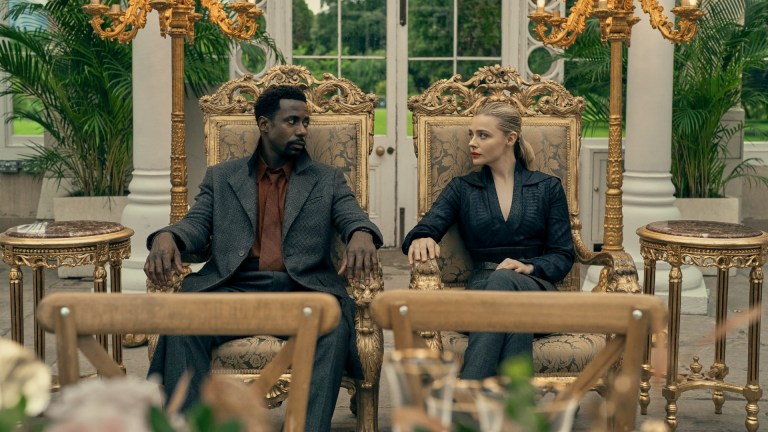How AI Brought Prime Video’s The Peripheral to Life
The use of futuristic technology adds flavor to the dual futures of Prime Video sci-fi series The Peripheral.

On Prime Video sci-fi series The Peripheral, the future is closer than you think.
And that’s because The Peripheral, based on a book 2014 book from genre titan William Gibson, actually features two futures. Produced by Westworld‘s Jonathan Nolan and Lisa Joy, The Peripheral takes place in both 2032 and 2099. In 2032, Appalachian everywoman Flynne Fisher (Chloë Grace Moretz) and her brother Burton (Jack Reynor) work as professional gamers who rich clients hire to assist them through particularly difficult portions of popular games.
One day, Flynne and Burton undertake an assignment set in a futuristic video game only for Flynne to discover that the 2099 world she has transported her avatar to isn’t virtual reality but reality reality. There, embodying a meatsuit resembling herself, Flynne must join forces with freedom fighters including Wilf Netherton (Gary Carr) to track down the enigmatic Aelita West (Charlotte Riley) to avoid disasters in both timelines.
Faithfully producing a fictional future from scratch is a tall order for any production team, let alone two. That’s why when director Vincenzo Natali (Splice) joined the project to helm the first two episodes, he knew he had to get the little details right.
“Usually when there’s a time travel story you start in the present and then head into the future or past or both. Rarely do you have a story where there is no present,” Natali tells Den of Geek.
Natali and production first made sure that the near future of 2032 felt close enough to our present, with sophisticated 3D printers, advanced military bio-haptic technology, and a cashless society, before tackling the far-flung and seemingly post-apocalyptic London of the late 21st century.
“Flynne’s world is close to our present but it’s not quite,” Natali says. “It did take a lot of thought to find the right alchemy of futurism and present day technology touchstones to make sure people understood where they were. To get into Flynne’s shoes before she rockets off into future London.”
Perhaps the easiest technological touchstone to get viewers acquainted to a conceivably real future is that of video game graphics. Many millennials and Gen-Xers will recall when video game processing power was the among the clearest guidelines to monitor technical advances, with the Nintendo 64 being even being so named because of its 64-bit CPU.
The video games of Flynne and Burton’s world are far beyond a 64-bit CPU. In fact, they’re darn near close to photo-realistic. When Flynne throws on her VR headset to enter into a World War II game, her avatar and her fellow soldiers look remarkably close to flesh and blood bodies, with only the slightest trace of outlining and washed out color betraying its artificiality. According to Natali, achieving this gaming look was crucial to establishing the realism of the show’s time travel conceit.
“I wondered that too – how to create iterations of virtual reality so when Flynne gets to future London it’s not so jarring for her like ‘oh this could’t possibly be a video game.’ We wanted to make sure the VR was close enough to reality but it was just walking around the edge of the uncanny valley.”
Amazingly, the effect of capturing that 2032 graphical interface wasn’t done with something like rotoscoping but with a technology that feels like its out of 2032 (or even 2099) itself: artificial intelligence. Natali and company shot scenes with real actors and then applied an artificial intelligence that had been trained to look at video games into the footage to interpolate the style.
“It came from an individual visual effects artist who suggested that,” Natali says. “I don’t know if you know about Midjourney and things like that but I’ve been playing a lot with these artificial intelligence programs that paint. You very quickly realize that the pipeline for visual effects is going to change and that AI is going to be a big part of that pipeline … in the not too distant future, as sci-fi as that sounds.”
That’s right. The same technology you use to create goofy images of Darth Vader ice fishing is now creating imagery from the future itself. Who knows what the video game technology of 2099 has in store!
Three episodes of The Peripheral are available to stream on Prime Video now. New episodes premiere each Friday through Dec. 2.
